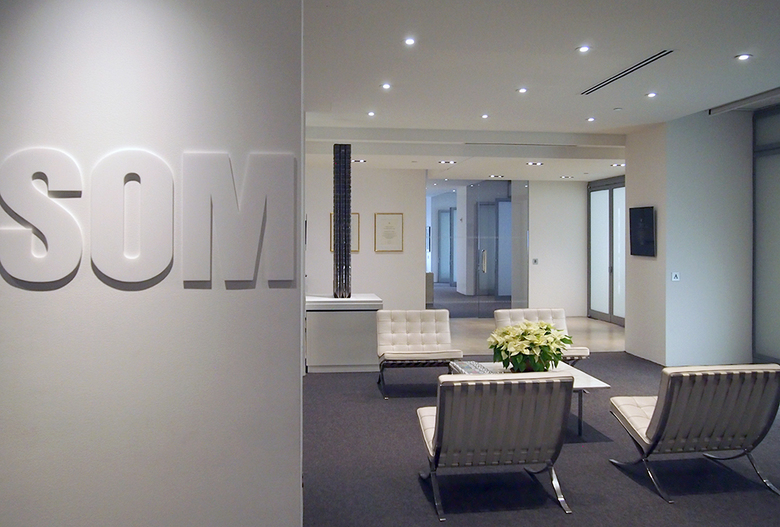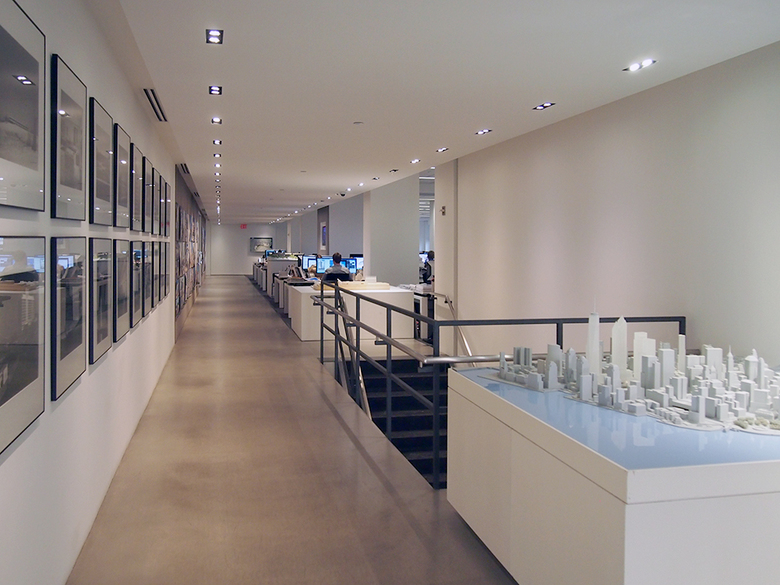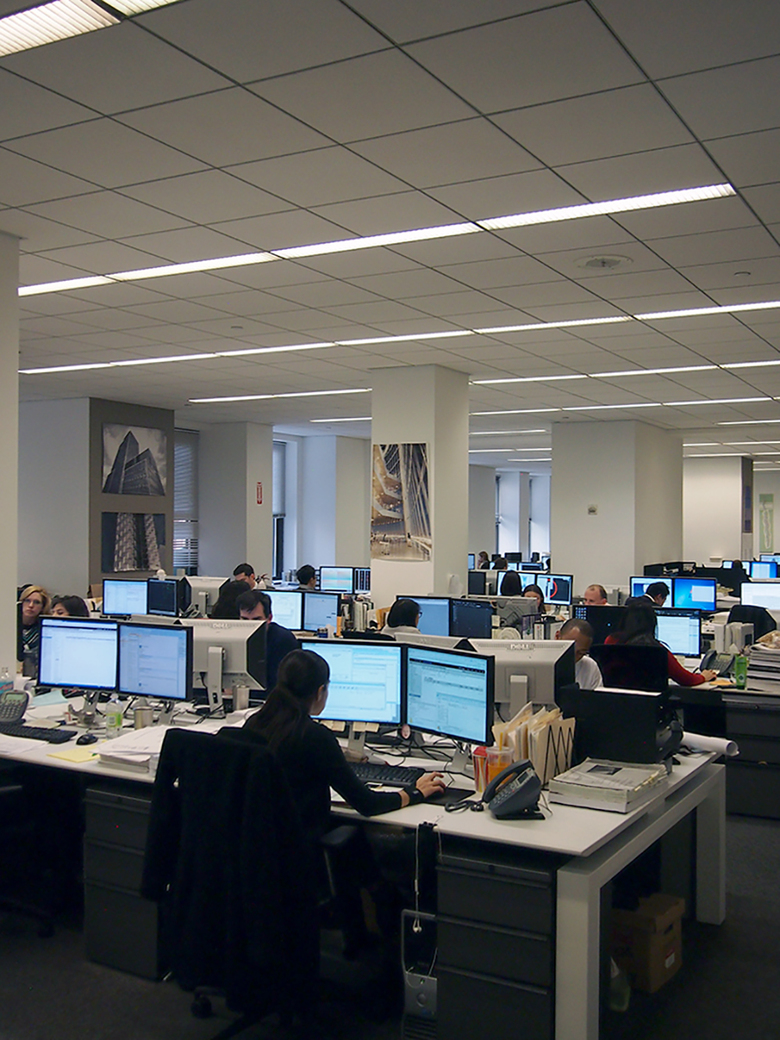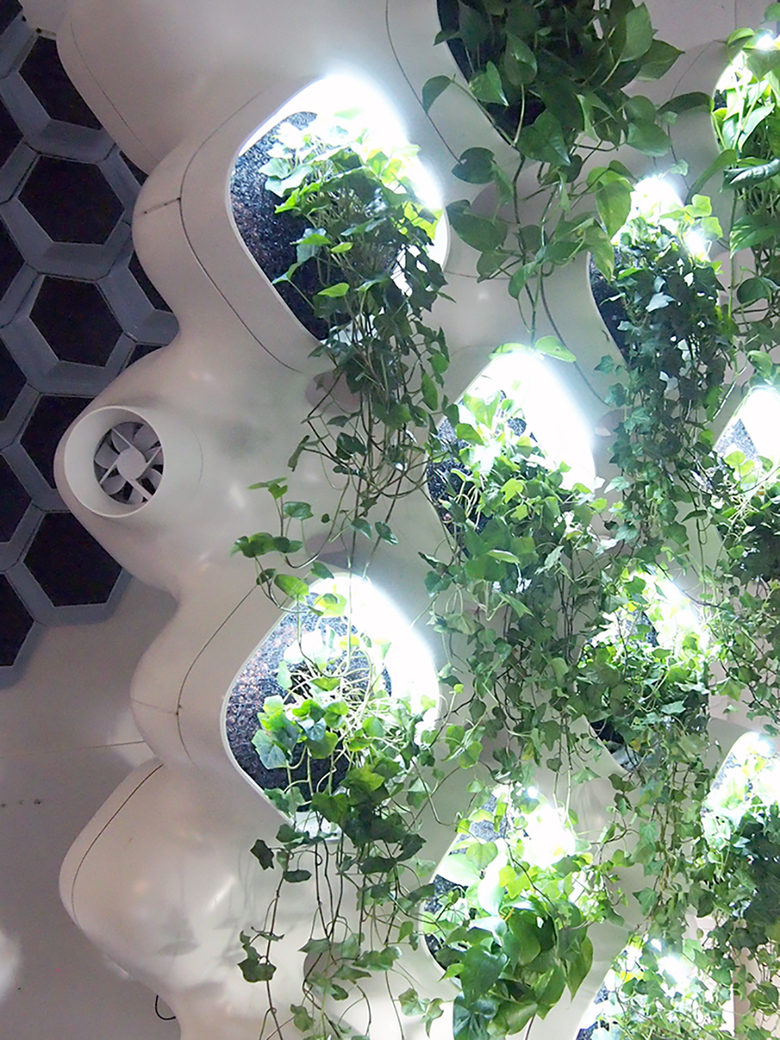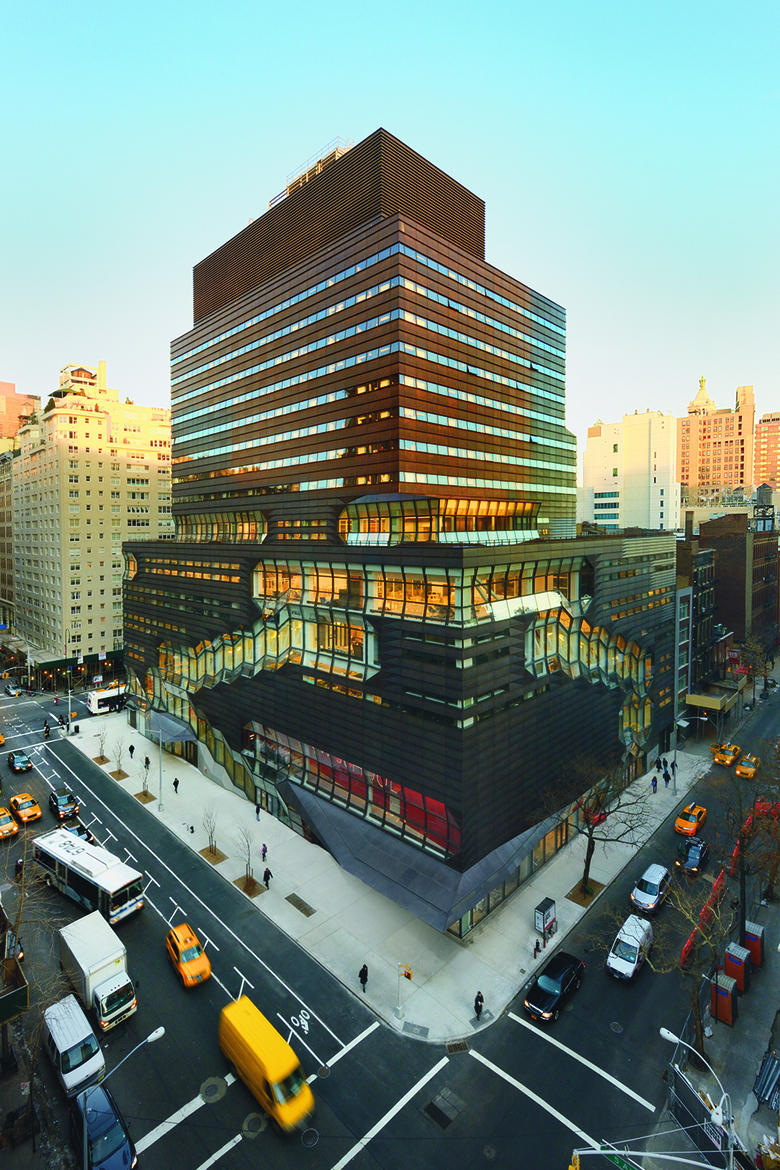Studio Visit: Skidmore, Owings & Merrill
John Hill
27. January 2014
SOM's 24th floor lobby. Photo: John Hill/World-Architects
In two years Skidmore, Owings & Merrill (SOM) will celebrate its 80th anniversary, having been founded on January 1, 1936. In the ensuing decades the firm has expanded from two offices in the United States to eleven offices on three continents, while becoming one of the most recognizable and significant architecture offices in the world. World-Architects recently visited the New York office of SOM to look around their two-floor Wall Street office space, speak with partners Roger Duffy and T.J. Gottesdiener, and see what projects are underway in the city and around the world.
Even before wending through the throngs of tourists in front of the New York Stock Exchange to head up to the 24th and 25th floors of 14 Wall Street across the street, a certain amount of baggage attaches itself to the name SOM and therefore my preconceptions. After all this is the firm that produced a number of last century's architectural icons – Lever House (New York, 1952), U.S. Air Force Academy Chapel (Colorado Springs, 1963), John Hancock Center (Chicago, 1970), and Sears Tower (Chicago, 1974) – by a roster of familiar names: Gordon Bunshaft, Walter Netsch, Bruce Graham, and Fazlur Khan. But this is SOM, which tellingly carries the names of its partners from the 1930s, not the subsequent and current generations of partners who are creating in this century some of SOM's most exciting buildings. This fact places the emphasis, as will be explored, on collaboration, networking, scale, and a multidisciplinary approach to architecture.
Stairs connecting floors 24 and 25. Photo: John Hill/World-Architects
The building at 14 Wall Street (aka the Bankers Trust Building) is a neoclassical limestone tower from 1912 that is capped by a distinctive stepped pyramid and wrapped by an Art Deco addition at its base. It's an unlikely setting for the firm responsible for mid-20th-century, open-plan office buildings like Chase Manhattan Bank Tower and Plaza, located just a few blocks to the north. Yet the neoclassical and Art Deco allusions are abandoned when stepping off the elevator into the crisp and modern lobby on the 24th floor. Conference rooms and partners' offices are visible on the right and beyond the lobby (top photo), while just past the Mies Barcelona chairs and reception desk is an open stair that runs parallel to the galleries that are the main circulation spines for the two floors. Open-plan studios sit on one side of the galleries, toward the windows, while facilities like the model shop sit next to the core. The office is fairly large, but the numerous large columns and elevator cores that rise through the building break down the scale of the spaces.
Gallery on 25th floor. Photo: John Hill/World-Architects
Lining the galleries are photographs, models and renderings that present SOM's past, present and future. One side of the gallery on the 24th floor is full of renderings of projects in varying states of progress, some of them documented with photos showing, where applicable, their state of construction. Opposite are models situated atop a partial height wall that separates the gallery from the design studio. These models highlight SOM's long held abilities in designing tall buildings – not to mention the abilities of the people in the model shop – but also the variety of work being produced today. Gone are the days when an SOM building meant something safe and expected, like a glass curtain wall on an orthogonal steel frame. Even within that idiom, today the firm produces buildings that are responsive to their contexts, finding the appropriate forms, materials and orientations depending on the place and time. As noted by historian Nicholas Adams in his excellent book, Skidmore, Owings & Merrill: The Experiment Since 1936 (Electa, 2006), this tactic owes much to SOM's otherwise forgettable Postmodern phase in the 1980s when context came to fore, considered at the time through historical references rather than original forms.
SOM design studio. Photo: John Hill/World-Architects
Preconceptions are one of the first things I discuss with design partner Roger Duffy and managing partner T.J. Gottesdiener in the latter's office, namely the strict structure of the SOM studio structure, in which employees traditionally communicated only with the person just above them, like a ladder from interns at the bottom to partners at the top. Gottesdiener explains that this is one aspect of SOM that has deliberately changed in recent years, through a flattening of their organizational structure toward more responsibility being given to a broader diversity of the staff. This flattening goes hand-in-hand with the collaborative nature of SOM, whose partners disassociate themselves from the belief in architecture as the product of a single voice, which the media (and many architects) are wont to promote. Duffy furthers this sentiment by pointing out the complexity of projects today, not only in terms of scale, technology and other conditions endemic to building types and architectural production, but in the mutli-faceted nature of clients today, as they have become more complex entities as well. Therefore projects often require teams to be assembled both in and out of house, something that SOM has traditionally excelled at thanks to their size and the broad reach of their services (architecture, engineering, planning and interiors, to name a few).
Models along 24th floor gallery. Photo: John Hill/World-Architects
One example of out-of-house collaborations that Duffy discusses is working with artists, which continues to this day but started in the late 1940s with the Terrace Plaza Hotel in Cincinnati, Ohio. Murals by Joan Miró and Saul Steinberg and sculptures by Alexander Calder and James Davis were created for spaces within SOM's slab-on-podium hotel design, what can be considered their first important commission for establishing them as a Modernist architectural practice. Most important is that these were bespoke artworks that worked with the architecture and arose at the same time, unlike the broader "plop art" of ensuing decades where the art came after the architecture and bore little relationship to it (Richard Serra's ill-fated Tilted Arc in Lower Manhattan is probably the most famous example). A contemporary example of SOM's artistic collaboration can be found in the relationship with James Turrell. The popular "artist of light" worked with Duffy on the entrance pavilion to the Greenwich Academy (Connecticut, 2002), while SOM has created the working drawings for Roden Crater, Turrell's magnum opus in the Arizona desert.
Model of Al Hamra Tower, Kuwait City. Photo: John Hill/World-Architects
With offices in New York, Chicago, San Francisco, Washington D.C., Los Angeles, Dulles, London, Hong Kong, Shanghai, Mumbai, Abu Dhabi, and Qatar, I wonder about how a firm with over 1,000 employees in all these cities is structured. Gottesdiener points out that SOM does not have a headquarters with a top-down structure. Rather, the offices function like a network based on functional considerations, with "the right talent in the right location for the right project." While this means that each office functions relatively independently from the others, the SOM umbrella enables expertise to be shared when appropriate. This situation is historically the case with SOM, not a recent phenomenon, harking back to the firm's origin. As Nicholas Adams describes in his 2006 book, Owings ran the Chicago office and Skidmore oversaw the work in New York. Later, the offices became defined primarily by their design partners, in particular Gordon Bunshaft in New York and Bruce Graham in Chicago.
Model of John Jay College. Photo: John Hill/World-Architects
In circa 2014 SOM, coming after some of the firm's big names either retired (David Childs, New York) or departed (Adrian Smith and Ross Wimer, Chicago), Roger Duffy has come to the fore as a leading design voice through his establishment of an educational group within the firm and the creation of the SOM Journal in 2000. The former has led to relatively small but nevertheless complex designs for primary and secondary education, including the aforementioned Greenwich Academy in Connecticut, the John Jay College of Criminal Justice and the just-inaugurated New School University Center, both in Manhattan. Duffy points out that the education studio is a "vehicle to do small scale projects with a different kind of momentum"; instead of 5-10 years, buildings are realized in 3-5 years. He equates these types of projects to the work carried out by Myron Goldsmith in the 1960s and 70s, particularly the McMath-Pierce Solar Telescopein Arizona and The Republic – Newspaper Plant & Offices, a building that helps to make Columbus, Indiana, an architectural mecca.
Sectional and detail models of Chhatrapati Shivaji International Terminal. Photo: John Hill/World-Architects
The SOM Journal, which printed its 8th issue last year (with Hatje Cantz, the journal's publisher since the beginning), invites outside critics and educators to select and comment upon a handful of the firm's projects in each issue. The critiques, which are published alongside the projects as well as essays and occasionally interviews, are intended to elevate the design produced by SOM. The journals also act as an outreach for the firm and express competition within the firm; the latter is particularly true in the case of the research projects that occasionally make their way into the journals.
Active Modular Phytoremediation System in CASE research center. Photo: John Hill/World-Architects
Harking back to SOM's "Computer Group" that crafted in-house CAD software from the 1960s to 80s, the research projects today deal with the relationship between architecture, technology and increasingly sustainability. Many of the projects start through the initiative of younger architects, evolving into ambitious plans. Most notable are the Great Lakes Vision Plan, the Timber Tower Research Project, the creation of the AEC-APPSlibrary of sharable architecture applications, and SOM's ongoing collaboration with CASE (Rensselaer's Center for Architecture Science and Ecology). CASE, which occupies a "wing" on the 24th floor of SOM's office, is developing, among other things, a phytoremediation system that will be incorporated in SOM's Public Safety Answering Centerin the Bronx, slated for completion in 2015. This project illustrates that the multi-faceted efforts of today's SOM – research, publications, and so forth – are geared to real-world applications and ultimately their full-scale realization.
Below we highlight four recent projects carried out by the New York office of SOM – the first two under construction and the second two recently inaugurated. Descriptions are courtesy SOM and, unless noted otherwise, images are also courtesy SOM.
United States Air Force Academy – Center for Character & Leadership Development
Colorado Springs, Colorado, 2014
In the 1950s, SOM famously master planned a rigorously modern campus for the U.S. Air Force Academy on a site abutting the Rocky Mountains. More recently, SOM revisited the campus — now a National Historic Landmark District — to design a home for the newly created Center for Character & Leadership Development.
United States Air Force Academy – Center for Character & Leadership Development. Image © SOM
The building’s most prominent feature, a 105-foot-tall skylight, symbolically serves as a navigation aid and as a reminder of the Academy’s core values. Shaped like an aircraft tailfin, this glass-enclosed structure precisely aligns with the North Star. The skylight also provides ample natural light for the Honor Board Room below.
United States Air Force Academy – Center for Character & Leadership Development. Image © SOM
Classrooms and offices ring two adjacent courtyards, maximizing exterior views and minimizing the need for artificial lighting. Earth tubes precool air entering the building, one of many sustainable features that will enable the building to earn LEED® Silver certification.
United States Air Force Academy – Center for Character & Leadership Development. Image © SOM
P.S.62 Net Zero Energy School
Staten Island, New York, 2015
P.S.62 will be the first net-zero energy school in New York City and the Northeast U.S. and one of the first of its kind worldwide. The 68,680-square-foot, two-story school will serve 444 pre-kindergarten through fifth grade students. When completed, the cutting-edge building will harvest as much energy from renewable on-site sources as it uses on an annual basis.
P.S.62 Net Zero Energy School. Image © SOM
Designed to comply with the SCA Green Schools Guide in lieu of LEED certification, the project will be NYC School Construction Authority’s first “sustainability lab.” This exploration into ultimate sustainability will provide substantial benefits to the City’s School Design Program and help achieve PlaNYC goals for significant reductions in global warming emissions. SOM’s design will offer an energy-use reduction of 50% over a SCA standard public school.
P.S.62 Net Zero Energy School. Image © SOM
SOM optimized the orientation and massing of the courtyard-shaped building to take advantage of sunlight for both ample daylighting and photovoltaic arrays on the roof and south façade. Other sustainable and low-energy features incorporated in the design include an ultra-tight high-performance building envelope, daylit offset corridors, energy-efficient lighting fixtures, low-energy kitchen equipment, a greenhouse and vegetable garden, a geo-exchange system, energy recovery ventilators and demand-control ventilation, and a solar thermal system for hot water.
P.S.62 Net Zero Energy School. Image © SOM
New School University Center
New York, New York, 2014
New School University Center (inaugurated 23 January 2014) adds 375,000 square feet of academic and student space to The New School’s Greenwich Village campus in downtown Manhattan. Conceived as a campus within a building, the University Center transforms the traditional university environment. Rather than compartmentalize learning, living, dining, and socializing spaces, these functions are situated in a vertical configuration, creating strategic adjacencies and heightening the university’s commitment to interdisciplinary learning. Connections between classrooms, studios, library, cafés, auditorium, and student residences take the form of stacked staircases and unprogrammed “sky quads” that facilitate the chance encounters vital to the cultivation of discussion and debate at the New School.
New School University Center. Photo: Martin Seck, courtesy of The New School
New School University Center. Photo: Kasia Broussalian, courtesy of The New School
Chhatrapati Shivaji International Terminal
Mumbai, India, 2014
The new Chhatrapati Shivaji terminal (inaugurated 10 January 2014) combines international and domestic passenger services under one roof, optimizing terminal operations in coordination with airline schedules. The highly flexible gating plan and terminal arrangement will ultimately accommodate forty million passengers per year and operate 24 hours a day. In keeping with the client’s goals, the design aims to reflect the spirit, heritage and traditions of Mumbai while simultaneously embodying the growth of technology in 21st century India. The primary design feature of the terminal is a long span roof covering the departures roadway, check-in hall, security and passport control functions. The roof and ceiling feature a sculptural surface and skylights, allowing natural light to flood into the main hall.
Chhatrapati Shivaji International Terminal. Photograph courtesy of Formglas
Chhatrapati Shivaji International Terminal. Photograph courtesy of Formglas
Related articles
-
Architects Reimagine the Chicago River
on 9/20/17
-
2017 AIA Institute Honor Awards Announced
on 1/13/17
-
The Four Best Tall Buildings for 2015
on 6/25/15
-
AIA Chicago Award Winners
on 10/27/14
-
Studio Visit: Skidmore, Owings & Merrill
on 1/27/14
